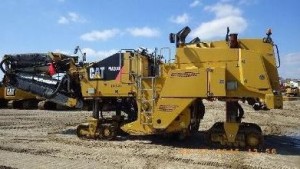Mon 23 Mar 2015
Silica controls for Milling Machines
Posted by admin under Air Monitoring, Asphalt, Concrete, Dust, Engineering Controls, Exposure, PEL (Perm Exp Limit), Silica, ventilation
Comments Off on Silica controls for Milling Machines
NIOSH (and with the help from some other groups) released a document this last week titled, “Best Practice Engineering Control Guidelines to Control Worker Exposure to Respirable Crystalline Silica during Asphalt Pavement Milling”. 
The issue: These machines are used to remove asphalt roads. They have a drum with teeth on them that essentially chew up the road and asphalt. A lot of respirable silica is generated (based upon the amount of silica in the rocks). The drums get really hot so water is used to cool it.  However, it does not control the respirable silica dust.  I’ve written (or, maybe complained) about the issue here, in 2010. And, I was informed, some good people were working on it.
The solution: The quick summary is: add more water and ventilation. Not rocket science, right? However, after reading this document, it might be. There’s a lot of information and specifics on what worked, and what didn’t. It was almost too much detail, but I suppose if you have a $200k+ machine, it is worth the time to figure it out. Below are some details:
- Case studies – adding water and increasing the pressure flow decreased airborne dust
- Tracer gas studies for ventilation effectiveness
- Checklists and flow rate controls
- Diagrams for where to direct water
Another benefit was the documentation of other’s work. There are numerous references  (5 pages!) to scientific articles. I did not notice any cost to implement the recommended changes, and I am curious to know what adding the ventilation system might run. Overall the document is good.
Finally, if you hold-on and continue reading to Appendix C, let me know what that all-means. Â 🙂
No Responses to “ Silica controls for Milling Machines ”
Sorry, comments for this entry are closed at this time.